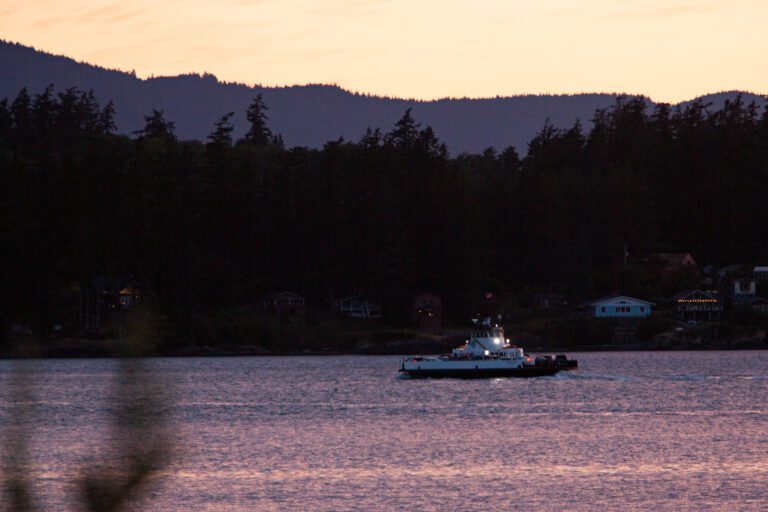Skagit County’s hearing for a proposed 51-acre gravel mine continued Friday afternoon, the third day of discussions regarding Concrete Nor’west’s request for a special-use permit for a 25-year operation.
The hearing initially began Aug. 26 and continued on Aug. 29 before resuming Friday morning. Throughout the hearing, attendees have offered public comment, listened to lawyers’ arguments for and against the special-use permit, and heard expert testimony about the environmental and social impacts a major gravel operation could have on the rural community.
“This is a very large site with a very small mine,” Bill Lynn, the lawyer representing Concrete Nor’west, said during his opening statement. “This is an extremely well-regulated project. It’s extraordinarily small. It’s on a site that is to be devoted to this use.”
In 2016, Miles Sand & Gravel proposed the mine, located deep in the woods off Grip Road, a rural route near Old Highway 99. The company proposes to log about 68 acres at the site to host a 51-acre mine for the next 25 years.
Neighbors are particularly concerned about the mine and the impacts it will have on their way of life. Chief among their concerns is the trucking on the small, rural roads.
Concrete Nor’west plans to haul around 23 loaded trucks off the property each day for gravel management at other facilities, meaning around 46 in-and-out trips each day, according to proposal documents.
Neighbors also worry about noise, vibrations and the environmental impacts of additional trucks and the logging process. Several attendees, including representatives from the Central Samish Valley Neighbors (CSVN) group, contend the project is not small or well regulated at this point.
Lawyers and attendees opposing the mine disagreed with Lynn’s evaluation of the site, and his opening statement resulted in jeers from the audience and prompted one attendee to yell “F— you, buddy!”
“My clients certainly view this industrial mining operation very differently from the extraordinarily small characterization that you just heard from the applicant,” said CSVN lawyer Kyle Loring. “We’re talking about the excavation and hauling of 4.28 million cubic yards over 25 years.”
Loring is an environmental and land use lawyer based in Friday Harbor.
“No responsible geologist could have reached the conclusion put forth by the applicants’ consultant that there’s no risk of landslide along Swede Creek as a result of traveling with that heavy gravel truck … on those steep roads,” Loring continued during his opening statements.
Dozens of residents spoke against the proposal last week, addressing traffic and safety concerns, as well as local fish populations and the history of the community.
Thirty-eight individuals, including neighbors, bicyclists and motorcyclists, environmentalists and commuters who drive on Grip Road every day, testified about the potential negative impacts of a new gravel mine during public comment. No one spoke in support of the proposal during the public comment period.
Several of the residents who testified lived near the proposed mine site for decades, including Don Jonasson, who moved to Prairie Road in the 1940s.
“The Grip Road mine proposal will generate intrusion on privacy and surrounding areas, and 100 percent will not maintain the character, landscape and lifestyle of the rural area,” Jonasson said during public comment. “It’s a result of the hauling from the mine. The Grip Road mine proposal is also in conflict with the health and safety of our community.”
Though county planners are not responsible for the final decision regarding the proposal, several attended the hearings.
“We’re supposed to protect long-term commercially available mineral resources, but we’re trying to balance the protection of mineral resources with community,” said Hal Hart, director of Skagit County Planning and Development Services. “We’re going to need those gravel resources in the future to keep our roads going and for new homes and for foundations … But that has to be balanced by all the environmental protections in place.”
Hart listened to public testimony throughout the first few days of hearings, hoping to learn more about resident concerns.
More than 2,000 pages of comments were submitted prior to the start of the hearing, according to Andrew Reeves, the hearing examiner for the proposal.
Following the hearings, Reeves is tasked with making a decision regarding the proposal, where he can approve the permit as it stands, deny the permit, or require additional studies.
Technological struggles and mistakes plagued the first day of the hearing, as the county supplied incorrect call-in numbers for remote participants. An incorrect phone number was listed on the official notice and the county website, meaning residents who wanted to participate virtually could not until the number was updated in the early afternoon.
Testimony will continue virtually Sept. 8 and 9.
This story was updated to include additional information about the ongoing hearing Tuesday, Sept. 6, at 2:14 p.m.




